Many people who go to the gym want to have a strong back with wide and stronger lats.
And Many people struggle with weak lats and weak upper backs due to their sedentary lifestyles and bad posture.
To combat this problem, it’s important to include exercises targeting the lats in your workout routine.
A strong back improves your physique and allows you to lift heavier weights on compound exercises like pull-ups, rows, and deadlifts.
Exercising your lat muscles a few times weekly will get bigger, thicker, and more defined over time.
In this blog post, I will share with you:
- Best exercises for lats.
- Proper form and technique for each exercise.
- Workout Plan
- Lats Anatomy

- Best Lats Exercises to Build V Shape Body
- 1. Pull-Ups
- 2. Renegade Row
- 3. Inverted Rows
- 4. One Arm Dumbbell Rows
- 5. Incline Dumbbell Row
- 6. Dumbbell Pullover
- 7. Lat Pulldowns
- 8. Seated Cable Rows
- 9. Straight Arm Lat Pulldown
- 10. T-Bar Rows
- 11. Bent-Over Barbell Rows
- 12. Meadows Row
- How to Build Bigger Lats (V-Taper)
- 1. Plan Training As Per Your Goal
- 2. Progressive Overload
- 3. Change The Training Volume
- 4. Focus On Form and Mind-Muscle Connection
- 5. Utilize Supersets and Drop sets
- 6. Development of Other Muscle Groups
- 7. Proper Nutrition
- 8. Adequate Rest
- Lats Workout Plan For Beginner
- Lat Workout Routine For Beginner
- Lat Workout Routine For Intermediate
- Latissimus Dorsi Muscle Anatomy
- FAQs
- Can You Get Bigger Lats At Home?
- How do I make my lats bigger?
- What are the best lat exercises with dumbbells?
- Bottom Line
Best Lats Exercises to Build V Shape Body
One of the most important muscles in the back, called the ‘lats’, helps support and stabilize the spine and gives a V-shape look.
Here are 12 of the best lats exercises to add to your workout routine to build a bigger V-Taper Back.
1. Pull-Ups
The pull-up is an upper-body strength movement that targets your lats, rear delts, and bicep. Performing a pull-up is often a challenge for beginners and even experienced athletes.
The pull-up increases your back’s strength, thickness, and width. The lats influence back width and form the “V” in the upper back.
To increase the variety of your pull-ups, you could try:
- Machine Assisted Chin-Ups And Pull-Ups
- Isometric Holds Pull-Ups And Chin-Ups
- Wide-Grip Pull-Ups
- Chin-Ups
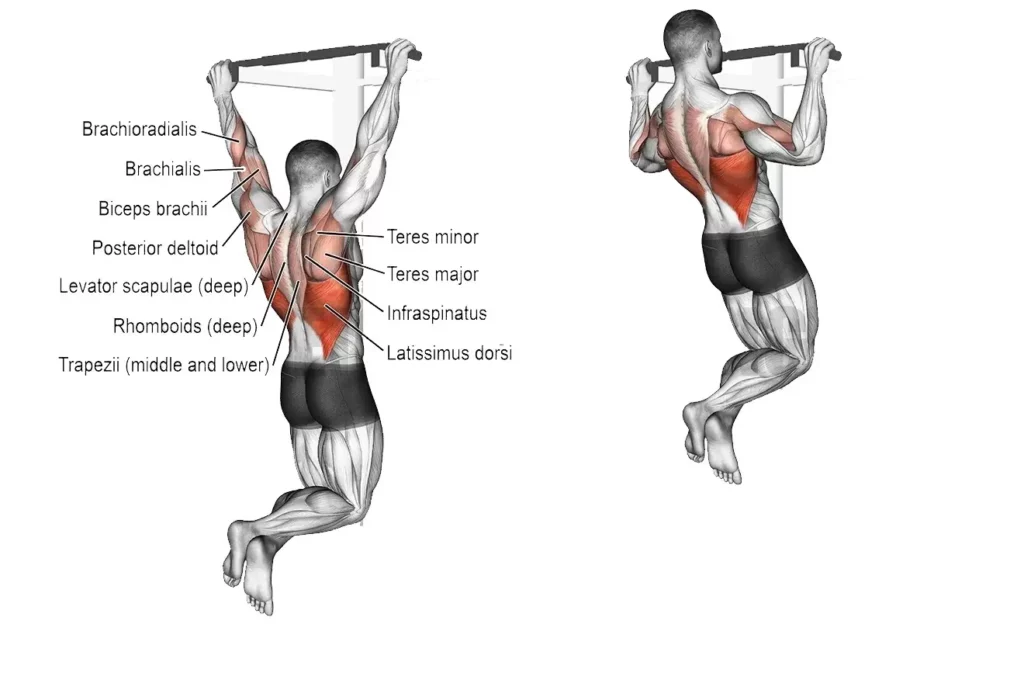
How To Do
- Start with your palms facing forward and your hands on the bar about shoulder-width apart.
- Hang from the bar with extended arms.
- Slowly pull your body up towards the bar.
- Hold and squeeze your lats momentarily once your chin is above the bar.
- Lower your body back to the starting position.
Tips
- Keep a controlled motion and avoid swinging or kicking your legs to generate momentum.
- If you cannot perform a full pull-up, try using an assisted pull-up machine or band for added support.
- You can also try different grip variations, such as a close, reverse, or neutral grip, to target different muscle fibers in your lats.
Related Post: Pull Ups Vs Chin Ups: The Ultimate Comparison
2. Renegade Row
The renegade row is a full-body exercise that targets the primary muscle groups of the lats, shoulders, and core while also engaging the triceps, biceps, and legs.
It is a variation of the traditional plank exercise that includes rowing movement with dumbbells.
You can also increase the intensity of this exercise by trying renegade row push-ups.
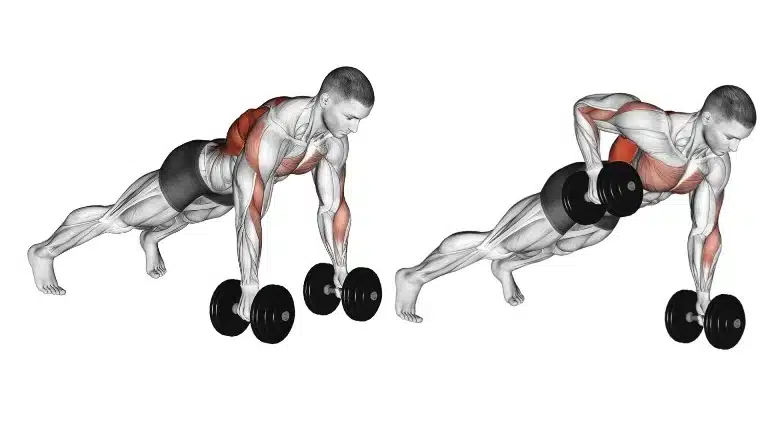
How To Do
- Take a plank position with a pair of dumbbells placed on the floor underneath your shoulders.
- Engage your core and maintain a neutral spine.
- Begin the exercise by rowing one dumbbell up to the side of your chest.
- Lower the dumbbell back down to the starting position.
- Perform the row with your other arm, and this completes one repetition.
Tips
- Focus on squeezing your shoulder blades together as you lift the weight.
- Make sure to start with a weight you can control and maintain proper form.
- Keep your elbows close to your body as you lift the weight.
3. Inverted Rows
The inverted row is also known as the bodyweight row. The inverted row is easier to perform because it puts your body horizontally.
It is a compound exercise that primarily targets the back muscles, specifically the lats, biceps, and rear deltoids.
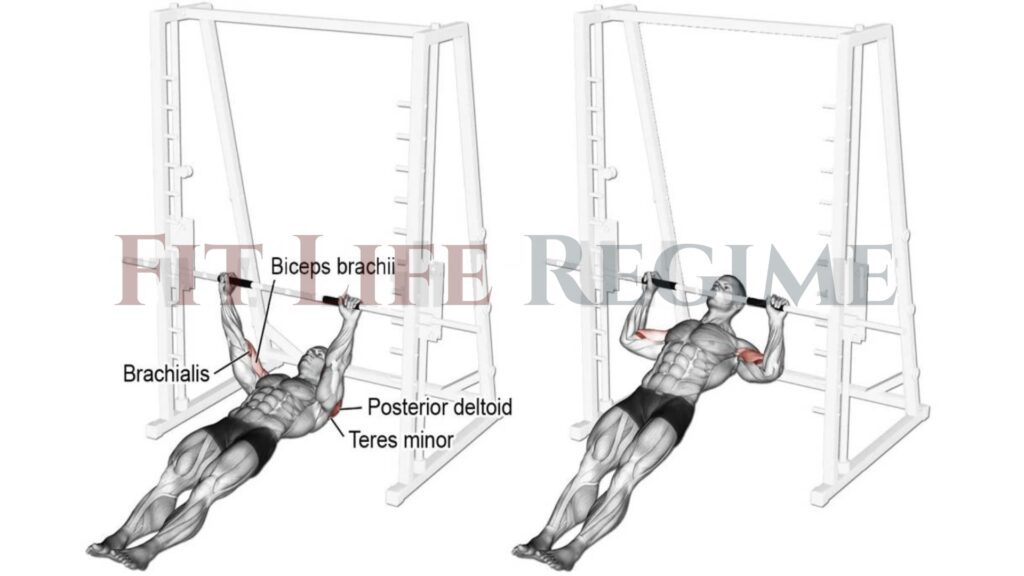
How To Do
- Start by setting up a barbell in a squat rack or Smith machine at a height that allows you to fully extend your arms at the bottom position of the movement.
- Lie underneath the barbell with your feet flat on the floor and your body in a straight line.
- Grasp the barbell with a pronated grip (palms facing away from you) and engage your core.
- Pull your chest towards the bar by bending at the elbows and squeezing your shoulder blades together.
- Pause momentarily at the top before lowering yourself back to the starting position.
- Repeat for as many reps and sets as desired.
Tips
- Keep your body straight throughout the movement to avoid swinging or using momentum.
- Engage your core to maintain proper form and stability.
Related Post: 15 Best Bodyweight Back Workout: Beginner To Advanced
4. One Arm Dumbbell Rows
One-arm dumbbell rows are a strength exercise that works your back muscles, specifically targeting your lats, rhomboids, and traps.
This exercise can be done with a single dumbbell that helps to work on each side independently, thereby providing better muscle isolation and a longer range of motion.
It’s an excellent alternative to barbell rows.
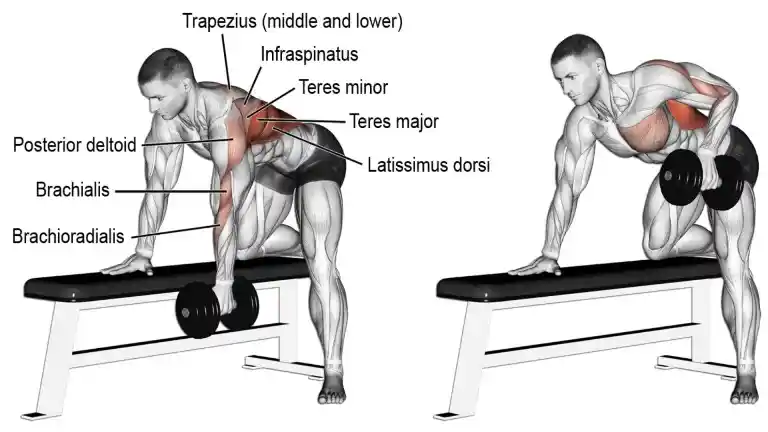
How To Do
- Hold a dumbbell in one hand and stand with your feet shoulder-width apart.
- Bend your knees slightly and then bend forward at the hips.
- Keep your back straight and parallel to the ground.
- Brace yourself on a flat bench or the ground with your other hand.
- Pull the dumbbell up towards your side, squeezing your back muscles at the top.
- Lower the dumbbell back down to the starting position.
Tips
- Keep your core engaged to maintain proper form and avoid swinging the weight.
- Make sure to keep your shoulder blades pulled together throughout the exercise.
- It is important to use a challenging weight but not so heavy that it causes you to lose your form.
5. Incline Dumbbell Row
The incline dumbbell row, or the chest-supported row, is an ideal row variation to get the best form, prevent mid-row rocking, reduce the risk of injury, and isolate the muscles you want to build.
Keeping your chest on the bench throughout the movement will eliminate momentum and work the muscles you want.
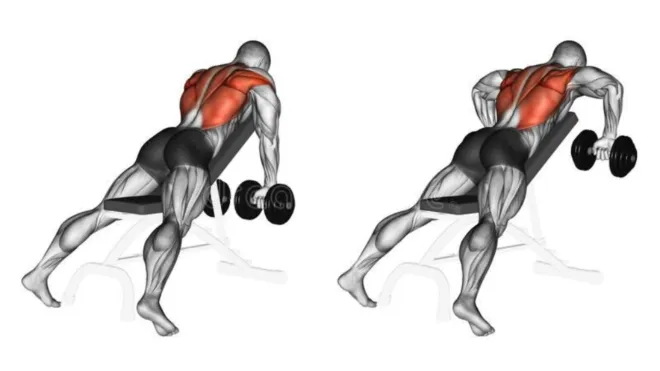
How To Do
- Adjust an incline bench and set it below 45 degrees.
- The bench should support your chest, with your chin above the top. Grasp a dumbbell in each hand.
- Let the dumbbells hang directly below your shoulders, with your palms facing each other and your elbows close to your body.
- Pull the weights as high as possible, squeezing your shoulder blades together at the top.
- Hold this position briefly before returning the dumbbells to the starting position.
Tips
- Keep movement under control, and don’t let gravity take you down faster.
- As you pull the dumbbells towards your body, don’t hyperextend the thoracic spine.
- Try to pinch your shoulder blades together at the top.
Read More: How To Perform The Chest Supported Row And Its Variations
6. Dumbbell Pullover
Barbell pullover is the best exercise to build a strong rib cage, outer lat, and serratus anterior muscle to build a complete chest and back.
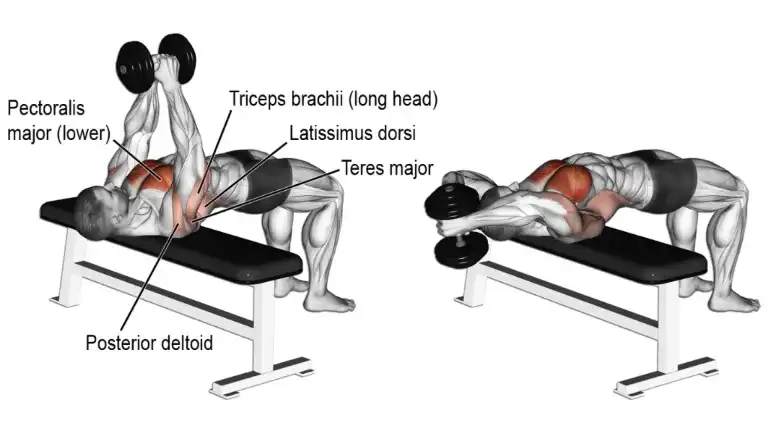
How To Do
- Lie on a flat bench with your head and upper back hanging off the end of the bench.
- Hold a dumbbell with both hands, keeping your arms straight and the weight over your chest.
- Lower the weight back over your head until you feel a stretch in your chest and Lats.
- Return to the starting position.
Tips
- Start with a light weight and gradually increase the weight as you become more comfortable with the movement
7. Lat Pulldowns
Lat Pulldowns are great for targeting the lats and other upper back muscles.
It is easy to learn and very effective at building back strength. It is commonly performed on a cable machine with a wide, horizontal bar attached to a pulley system.
To increase the variety of your lat pulldown, you could try:
- Close grip Lat pulldown
- One-Arm Lat Pulldown
- V-Grip Lat Pulldown
Note: According to a study, the front of the neck technique works better for activating the lats muscles than the behind-the-neck and V-bar techniques.
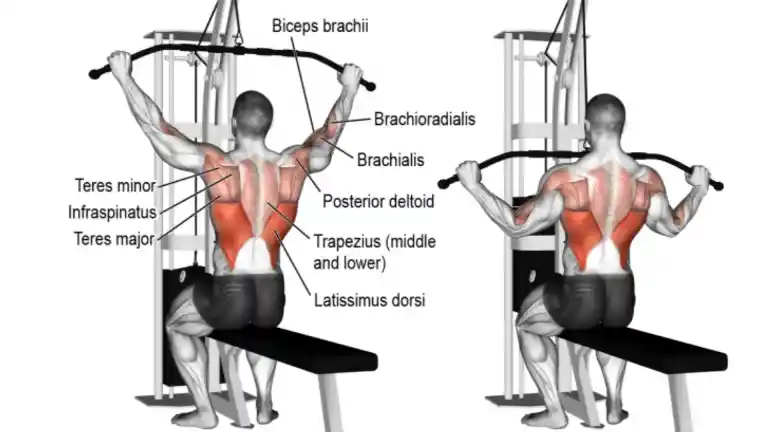
How To Do
- Sit down and place your legs under the pads to secure your knees.
- Grip the bar using a wide overhand grip, slightly wider than shoulder width. A
- Pull the bar downwards towards your upper chest. To perform this action, focus on using your lats, not your biceps.
- Your elbows should point downwards and a bit to the rear as you pull the bar.
- Pull the bar down until it almost touches your upper chest. Don’t swing the torso.
- Focus on squeezing your lats at the bottom of the movement for maximum muscle engagement.
- Release the bar back to the starting position with your arms fully extended and feel the stretch in your lats.
Tips
- Avoid using momentum to pull the bar down.
- Keep your back straight while sitting up, and slightly lean back.
- Make sure to use a grip that is comfortable for you and a weight that you can comfortably control.
Read More: 18 Best Cable Back Workout And Exercises For Wider Back
8. Seated Cable Rows
Seated cable rows are a strength exercise that works your lats, rhomboids, and lower back muscles.
It is a great exercise for building a stronger, more defined back.
This back exercise is done on a cable rowing machine with separate handles and grip position change, and the muscle worked involvement.
- A pronated (overhand) grip targets the upper and middle trapezius.
- A neutral (thumbs up) grip hits the middle and lower trapezius.
- The supinated (underhand) grip switches the focus to the latissimus dorsi.
Try Different variations of seated cable rows:
- Seated One Arm Cable Row
- Wide Grip Seated Row
- Close Grip Seated Row
- Reverse grip seated cable row
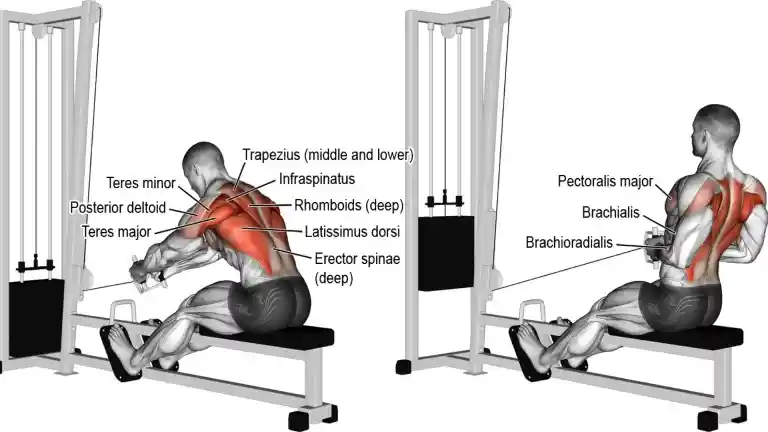
How To Do
- Start by sitting at a cable machine with a straight bar or v-bar attached to the low pulley.
- Grasp the bar, sit up straight, and keep your feet flat on the floor.
- Pull the bar towards your lower chest, keeping your elbows close to your body.
- Once you reach the final position, hold for a count and squeeze your muscles.
- Return to the starting position and repeat for as many reps and sets as desired.
Tips
- Avoid using too much weight, as this can cause you to use momentum instead of your back muscles.
- Maintain a good posture throughout the exercise and avoid leaning back too far.
- Keep your shoulders down and back, and avoid shrugging your shoulders during the exercise.
9. Straight Arm Lat Pulldown
The straight arm lat pulldown is one of the best exercises to strengthen your lats (back). This isolation exercise can also help to improve your posture and build a bigger back.
While the exercise will primarily target the lats, you will also notice a fair amount of bicep and middle back activation.
This is a great exercise that can really help you widen your upper back.

How To Do
- Take an overhand grip that is wider than shoulder-width on a lat bar attached to the pulley on the lat pulldown bar.
- Position yourself with your feet flat on the floor, chest up, and low-back arch exaggerated.
- Pull your shoulder blades together and squeeze your back to start the movement.
- Then, pull the bar down to your midsection.
- Hold the contraction for a moment, then slowly return the bar all the way back to the starting position.
Tips
- Don’t allow the head to jut forward as you pull.
- Keep your elbows slightly flexed and your body still
10. T-Bar Rows
T-Bar Rows are strength exercises that specifically target your lats and rhomboids. It is a great compound move that helps to build a stronger, wider back.
A chest-supported t-bar machine row can be done with different grips, such as an overhand, reverse, or neutral grip.
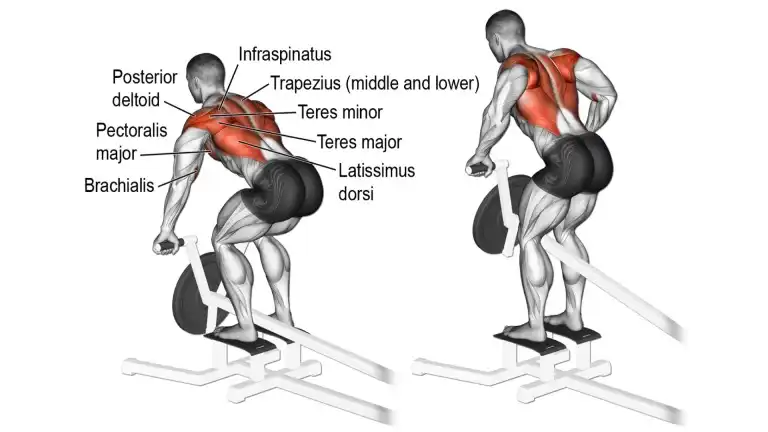
How To Do
- Start by positioning yourself with your feet on the footplate of the T-bar row machine.
- Grasp the bar with an overhand grip and pull it towards your lower chest, squeezing your shoulder blades together.
- Slowly release the bar back to the starting position.
- Repeat for as many reps and sets as desired.
Tips
- Keep your back straight and avoid hunching over during the exercise.
- Focus on squeezing your shoulder blades together at the top of the movement.
Read More: How To Perform The Chest Supported Row And Its Variations
11. Bent-Over Barbell Rows
Bent-over barbell rows are a great exercise for targeting your lats and your middle and lower back muscles.
This compound movement works for multiple muscle groups at once, making it an efficient and effective exercise for building a stronger back.
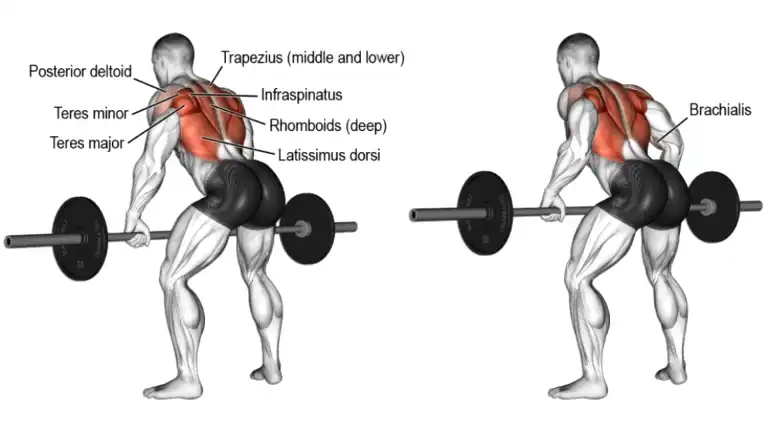
How To Do
- Start by standing with your feet hip-width apart and your knees slightly bent.
- Bend over at the hips and grab the barbell with a wide overhand grip.
- Keep your back straight and pull the barbell up towards your stomach.
- Lower the barbell back to the starting position.
Tips
- Keep your back straight and avoid rounding your shoulders.
- Keep your elbows close to your body throughout the movement.
- Control the movement, and avoid using momentum to lift the weight.
Related Post: Barbell Lat Workouts For Bigger And Stronger Back
12. Meadows Row
When doing a lat workout with a barbell, you can add plenty of single-arm exercises to correct potential imbalances.
The meadow row is a unilateral landmine exercise used to target the back muscles. This exercise targets the latissimus dorsi, trapezius, and rear deltoid muscles.
If done properly, it will create small muscle tears, which will heal and cause your muscles to grow stronger and larger.

How To Do
- Place a barbell in a landmine attachment or against the wall.
- Hinge forward with a staggered stance and grab the barbell with an overhand grip.
- Start the movement by driving the elbow behind the body while retracting the shoulder blade.
- Pull the barbell towards your hip until the elbow is at or near the midline.
- The barbell should be slowly lowered back to its starting position.
- Do the exercise for the desired number of repetitions on both sides.
Tips
- Don’t allow momentum to carry the barbell through the movement. Keep control of the bar throughout each rep.
- Make sure to allow your arm to hang down for a greater stretch and improved range of motion.
- Ensure you keep your core tight, and don’t forget to breathe as you lift up and lower back down.
How to Build Bigger Lats (V-Taper)
Here are some tips for building bigger lats:
1. Plan Training As Per Your Goal
- For muscle endurance: Aim for 3–4 sets of 12–15 reps, with moderate resistance.
- For muscle strength: Aim for 3–5 sets of 6–10 reps, with more resistance.
- For muscle hypertrophy (increased muscle size): Aim for 3–4 sets of 8-12 reps, with a moderate to heavy amount of resistance.
It is always best to start with fewer reps and sets, and then gradually increase as your strength improves.
2. Progressive Overload
To build a bigger back, you must focus on gradually increasing the weight used for LAT exercises over time. This will help stimulate muscle growth.
Doing higher sets and reps for LAT exercises can help to increase overall volume and stimulate muscle growth.
3. Change The Training Volume
Training volume is considered to be the product of intensity, number of repetitions performed, and total number of sets in a workout. Volume can also account for the time under tension or tempo (speed) of the exercises.
Training the lats once or twice a week may be sufficient for some individuals, while others may need to train thrice a week.
If growth is not seen, increasing training frequency from 1–2 times a week to 2–3 times a week may help.
4. Focus On Form and Mind-Muscle Connection
It’s important to do exercises correctly and focus on tightening and stretching the lat muscles. This will make them work better.
Take the time to learn and practice the correct form for each exercise.
5. Utilize Supersets and Drop sets
- Drop sets involve doing a set until you fail, then reducing the weight and doing the same exercise until you fail again.
- Supersets involve performing two consecutive exercises, with the rest only occurring after the second one.
It can be beneficial to incorporate supersets and drop sets into your workout routine, as they can provide a greater stimulus for muscle growth.
6. Development of Other Muscle Groups
To get a V-taper physique, you must build bigger lats and other muscle groups, such as the shoulders, traps, and abs.
Getting bigger shoulders and traps will make your upper body V look.
7. Proper Nutrition
Bodybuilders, trainers, and experts on diets will tell you that when building a body, you should pay more attention to what you eat.
Beginning or returning to the gym after a layoff can expect to make some serious gains in strength and mass from a regular training program, but not without a solid nutrition program.
Eating a well-balanced diet with adequate protein, carbohydrates, and healthy fats is essential for building muscle.
Studies show that eating 20-40 grams of protein is enough to maximize muscle growth.
The easiest way to figure out how many calories and nutrition you need is to use our weight gain calculator.
8. Adequate Rest
If your workout plan involves consecutive days of training, be sure to switch up the muscle groups each day. This way, each muscle group gets a rest period of at least 48-72 hours between training sessions.
Be sure to get enough sleep and allow for adequate rest between workout sessions.
Know More: 18 Ways to Maximize Muscle Recovery After Intense Workout To Gain Mass, Strength And Endurance
Lats Workout Plan For Beginner
The number of sets and reps can gradually increase as the individual becomes more comfortable with the exercises and their form improves.
It is also recommended to vary the exercises and use different equipment to target the Lats from different angles.
Lat Workout Routine For Beginner
Here is a beginner-friendly lat workout routine that can be done anywhere:
| Exercise | Sets | Reps |
|---|---|---|
| Pull-Ups (assisted) | 3-4 | 8-10 |
| Lat Pulldowns | 3-4 | 8-12 |
| Dumbbell Rows | 3 | 8-10 |
| Dumbbell Pullovers | 3-4 | 8-12 |
Lat Workout Routine For Intermediate
Here is an intermediate workout routine:
| Exercise | Sets | Reps |
|---|---|---|
| Lat Pulldowns | 4 | 10-12 |
| Barbell Rows | 3 | 8-10 |
| Dumbbell Pullovers | 3 | 12-15 |
| Seated Cable Rows | 4 | 8-12 |
Latissimus Dorsi Muscle Anatomy
The latissimus dorsi muscle, commonly known as the “lats,” is a large, triangular muscle located in the upper back and sides of the torso.
It originates on the lower six thoracic vertebrae, the lumbar vertebrae, and the iliac crest of the pelvis and inserts on the humerus (upper arm bone).
The lats function to extend, adduct, and internally rotate the arm, as well as to stabilize the shoulder blade and assist in spinal extension.
They are also involved in other movements such as pull-ups and chin-ups, rowing exercises, and even some core exercises.
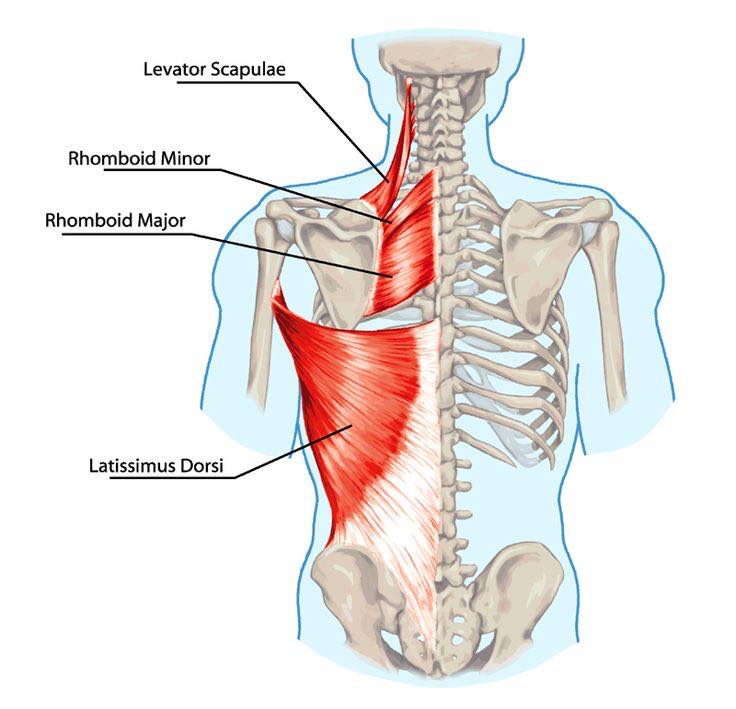
FAQs
Can You Get Bigger Lats At Home?
Yes, it is possible to get bigger lats at home with proper exercise selection, training intensity, and progressive overload.
Bodyweight exercises such as pull-ups and chin-ups, resistance band exercises, and free weight exercises with dumbbells or kettlebells can be used to target the lats.
How do I make my lats bigger?
To make your lats bigger, you should incorporate lat-specific exercises like pull-ups and rows into your workout routine and increase the intensity and volume of your training over time.
Also, maintain a caloric surplus in your diet, and allow adequate rest and recovery time between workouts.
What are the best lat exercises with dumbbells?
Some of the best lat exercises with dumbbells are:
- Dumbbell Rows
- Dumbbell Pullovers
- One Arm Dumbbell Row
- Dumbbell Deadlifts.
These exercises allow you to target the lats with the added resistance of dumbbells, which can help increase strength and muscle growth.
Bottom Line
Building a stronger back is crucial for overall fitness and health.
Exercises like pull-ups, lat pulldowns, barbell rows, and dumbbell pullovers are good ways to work on the lats and improve upper body strength.
Each exercise offers unique benefits and challenges, from pull-ups to bent-over barbell rows.
Additionally, it’s recommended to integrate Lat exercises into a balanced workout routine that includes other exercises for the upper body, lower body, and core.
Thanks for reading, enjoy working your workout!
References
- Andersen, V., Fimland, M. S., Wiik, E., Skoglund, A., & Saeterbakken, A. H. (2014). Effects of grip width on muscle strength and activation in the lat pull-down. Journal of Strength and Conditioning Research, 28(4), 1135-1142. doi:10.1097/JSC.0000000000000232.
- Sperandei S, Barros MA, Silveira-Júnior PC, Oliveira CG. Electromyographic analysis of three different types of lat pull-down. J Strength Cond Res. 2009 Oct;23(7):2033-8. doi: 10.1519/JSC.0b013e3181b8d30a. PMID: 19855327.

Manish is a NASM-certified fitness and nutrition coach with over 10 years of experience in weight lifting and fat loss fitness coaching. He specializes in gym-based training and has a lot of knowledge about exercise, lifting technique, biomechanics, and more.
Through “Fit Life Regime,” he generously shares the insights he’s gained over a decade in the field. His goal is to equip others with the knowledge to start their own fitness journey.
